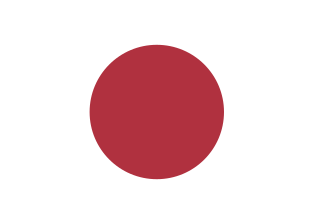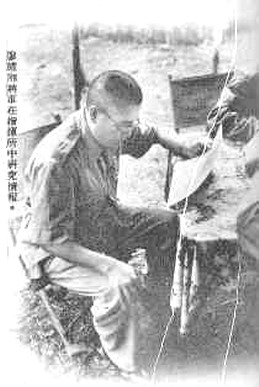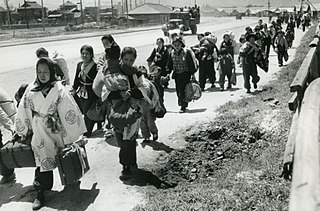
The Chinese Civil War was fought between the Kuomintang-led government of the Republic of China and the forces of the Chinese Communist Party, with armed conflict continuing intermittently from 1 August 1927 until 7 December 1949, resulting in a Communist victory and subsequent control of mainland China.

Manchukuo was a puppet state of the Empire of Japan in Northeast China that existed from 1932 until its dissolution in 1945. It was ostensibly founded as a republic, its territory consisting of the lands seized in the Japanese invasion of Manchuria; it was later declared to be a constitutional monarchy in 1934, though very little changed in the actual functioning of government. Manchukuo received limited diplomatic recognition, mostly from states aligned with the Axis powers, with its existence otherwise widely seen as illegitimate.

The Second Sino-Japanese War, also known as the Second China–Japan War and the Chinese War of Resistance against Japanese Aggression, was fought between the Republic of China and the Empire of Japan from 1937 to 1945 as part of World War II. This total war between China and the Empire of Japan is often regarded as the beginning of World War II in Asia, although some scholars consider the European War and the Pacific War to be entirely separate, albeit concurrent. It was the largest Asian war in the 20th century and has been described as "the Asian Holocaust", in reference to the scale of Imperial Japan's war crimes against Chinese civilians. After the Japanese attacks on Malaya and Pearl Harbor in 1941, the war merged with other conflicts which are generally categorized under the China Burma India Theater of World War II by the Western allies.

Changchun is the capital and largest city of Jilin Province in China. Lying in the center of the Songliao Plain, Changchun is administered as a sub-provincial city, comprising 7 districts, 1 county and 3 county-level cities. According to the 2020 census of China, Changchun had a total population of 9,066,906 under its jurisdiction. The city's metro area, comprising 5 districts and 1 development area, had a population of 5,019,477 in 2020, as the Shuangyang and Jiutai districts are not urbanized yet. It is one of the biggest cities in Northeast China, along with Shenyang, Dalian and Harbin.

The Mukden incident was a false flag event staged by Japanese military personnel as a pretext for the 1931 Japanese invasion of Manchuria.

Northeast China is a geographical region of China, also called Manchuria in history. It usually corresponds specifically to the three provinces east of the Greater Khingan Range, namely Liaoning, Jilin, and Heilongjiang, but historically is meant to also encompass the four easternmost prefectures of Inner Mongolia west of the Greater Khingan. The heartland of the region is the Northeast China Plain, the largest plain in China, with an area of over 350,000 km2 (140,000 sq mi). It is separated from Russian Far East to the north by the Amur, Argun, and Ussuri Rivers; from Korea to the south by the Yalu and Tumen Rivers; and from Inner Mongolia to the west by the Greater Khingan and parts of the Xiliao River.

The Soviet invasion of Manchuria, formally known as the Manchurian strategic offensive operation or simply the Manchurian operation, began on 9 August 1945 with the Soviet invasion of the Japanese puppet state of Manchukuo. It was the largest campaign of the 1945 Soviet–Japanese War, which resumed hostilities between the Union of Soviet Socialist Republics and the Empire of Japan after almost six years of peace. Since 1983, the operation has sometimes been called Operation August Storm after U.S. Army historian David Glantz used this title for a paper on the subject.

The Tanggu Truce, sometimes called the Tangku Truce, was a ceasefire that was signed between the Republic of China and the Empire of Japan in Tanggu District, Tianjin, on May 31, 1933. It formally ended the Japanese invasion of Manchuria, which had begun in 1931.

Huludao, formerly known as Jinxi (锦西) until 1994, is a coastal prefecture-level city in southwestern Liaoning province, People's Republic of China. Its name literally means "Gourd Island", referring to the fiddle-shaped contour of the peninsula, which resembles a bottle gourd, at the city's Longgang District. It has a total area of 10,582 km2 (4,086 sq mi) and as of the 2020 census a population of 2,434,194 of whom 1,252,660 inhabitants lived in the built-up area made of the 2 urban districts and Xingcheng City largely being conurbated.

The Liaoshen campaign, an abbreviation of Liaoning–Shenyang campaign after the province of Liaoning and its Yuan directly administered capital city Shenyang, was the first of the three major military campaigns launched by the Communist People's Liberation Army (PLA) against the Kuomintang Nationalist government during the late stage of the Chinese Civil War. This engagement is also known to the Kuomintang as the Liaohsi campaign, and took place between September and November 1948, lasting a total of 52 days. The campaign ended after the Nationalist forces suffered sweeping defeats across Manchuria, losing the major cities of Jinzhou, Changchun, and eventually Shenyang in the process, leading to the capture of the whole of Manchuria by the Communist forces. The victory of the campaign resulted in the Communists achieving a strategic numerical advantage over the Nationalists for the first time in its history.

The siege of Changchun was a military blockade undertaken by the People's Liberation Army against Changchun between May and October 1948, the largest city in Manchuria at the time, and one of the headquarters of the Republic of China Army in Northeast China. It was one of the longest campaigns in the Liaoshen Campaign of the Chinese Civil War.

Japanese orphans in China consist primarily of children left behind by Japanese families following the Japanese repatriation from Huludao in the aftermath of World War II. According to Chinese government figures, roughly 4,000 Japanese children were left behind in China after the war, 90% in Inner Mongolia and northeast China. They were adopted by rural Chinese families.

The Pacification of Manchukuo was a Japanese counterinsurgency campaign to suppress any armed resistance to the newly established puppet state of Manchukuo from various anti-Japanese volunteer armies in occupied Manchuria and later the Communist Northeast Anti-Japanese United Army. The operations were carried out by the Imperial Japanese Kwantung Army and the collaborationist forces of the Manchukuo government from March 1932 until 1942, and resulted in a Japanese victory.

The Northeast Anti-Japanese United Army was the main anti-Japanese guerrilla army in Northeast China (Manchuria) after the Japanese invasion of Manchuria in 1931. Its predecessors were various anti-Japanese volunteer armies organized by locals and the Manchuria branches of the Chinese Communist Party (CCP). In February 1936, the CCP, in accordance with the instructions of the Communist International, issued The Declaration of the Unified Organization of Northeast Anti-Japanese United Army and marked the official formation of the organization.

The territorial conquests of the Empire of Japan in the Western Pacific Ocean and East Asia began in 1895 with its victory over Qing China in the First Sino-Japanese War. Subsequent victories over the Russian Empire and German Empire expanded Japanese rule to Taiwan, Korea, Micronesia, southern Sakhalin, several concessions in China, and the South Manchuria Railway. In 1931, Japan invaded Manchuria, resulting in the establishment of the puppet state of Manchukuo the following year; thereafter, Japan adopted a policy of founding and supporting puppet states in conquered regions. These conquered territories became the basis for the Greater East Asia Co-Prosperity Sphere in 1940.

Liao Yiaoxiang, was a high-ranking Kuomintang commander who successful fought against both the Imperial Japanese Army and Chinese Communist forces. Apart from General Sun Liren, he was one of the few Nationalist commanders who graduated from a military academy in the West. After the end of the Second Sino-Japanese War, he served as a field commander in Manchuria until his capture by Marshal Lin Biao's Manchurian Field Army in the Liaoshen Campaign. General Liao was held for 12 years as a prisoner of war until 1961 and died seven years later during the Cultural Revolution.

Operation Beleaguer was the codename for the United States Marine Corps' occupation of northeastern China's Hebei and Shandong provinces from 1945 until 1949. The Marines were tasked with overseeing the repatriation of more than 600,000 Japanese and Koreans that remained in China at the end of World War II. During the four-year occupation, American forces engaged in several skirmishes with the People's Liberation Army while successfully evacuating thousands of foreign nationals. The United States Government attempted to mediate a peace treaty between the opposing Nationalist and Communist factions but was unsuccessful. The Marines departed Northern China in June 1949 a few months before the communists won victory in the Chinese Civil War and took control of mainland China.

The Port of Huludao is an artificial deep-water international seaport on the coast of Huludao, Liaoning, People's Republic of China, on the Liaodong Bay. It is one of several smaller ports being rapidly expanded in Liaoning Province in order to service the Northeast.
Kunio Maruyama was a Japanese businessman, adventurer, and college professor of English and economics. He was one of the three Japanese men who were secretly sent from Xinjing's Japanese Society, that led to the successful repatriation of most of the 1.6 million Japanese who had been trapped in the former Manchukuo at the end of World War II.

The Japanese settlers in Manchuria were the Japanese immigrants who came to Manchuria after the Russo-Japanese War and settled in zones of Japanese interests.



















